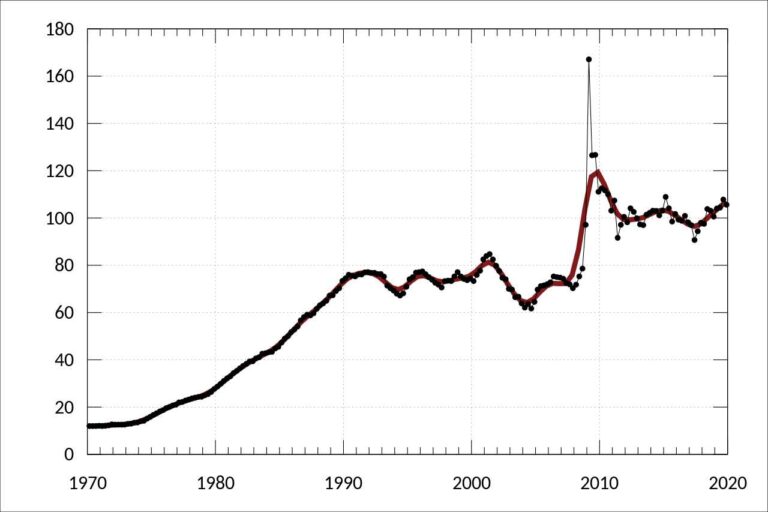Producer Price Index (PPI): Meaning, types, components and more

The Producer Price Index (PPI) is a significant economic indicator that measures the average change in prices received by domestic producers for their goods and services. It provides valuable insights into the inflationary pressures in the economy and serves as an early warning sign for future changes in consumer prices.
In this article, we will discuss the meaning of PPI and its various components, calculation methods, and uses.
What is the Producer Price Index (PPI)?
The Producer Price Index (PPI) is a statistic tool measuring the average change in prices received by domestic producers of goods and services over time. It is used to track inflationary pressures in the economy and serves as an important tool for economists and policymakers in monitoring the health of the economy. The PPI provides information about the price movements of goods and services produced by domestic producers and reflects the costs faced by these producers in producing the goods and services they sell.
The PPI covers a wide range of goods and services, including finished goods, intermediate goods, and crude goods. The finished goods category covers goods that are ready for sale to consumers, while intermediate goods are used in the production of finished goods. Crude goods are raw materials used in the production process.
The PPI is calculated using a basket of goods and services and is expressed as an index number. The basket is chosen to reflect the goods and services produced by domestic producers and is weighted based on their relative importance in the economy. The PPI is calculated based on the prices received by domestic producers for their goods and services and is expressed as a percentage change from a base period.
The PPI is considered a leading indicator of inflation, as changes in the prices faced by producers often precede changes in consumer prices. As a result, the PPI is closely watched by economists, policymakers, and investors, who use it to anticipate future changes in consumer prices and monitor inflationary pressures in the economy.
Components of the PPI and its calculation
The components of the Producer Price Index (PPI) reflect the various goods and services produced by domestic producers. The components of the PPI include finished goods, intermediate goods, and crude goods.
Finished goods are goods that are ready for sale to consumers, and they represent the final stage of the production process. Examples of finished goods include consumer goods such as food and household items, as well as capital goods such as machinery and equipment. The PPI for finished goods is used to track changes in the prices of goods that are ready for sale to consumers.
Intermediate goods are goods used in the production of finished goods, and they represent an intermediate stage of the production process. Examples of intermediate goods include raw materials, components, and semi-finished goods. The PPI for intermediate goods is used to track changes in the prices of goods that are used in the production of finished goods.
Crude goods are raw materials used in the production process, and they represent the earliest stage of the production process. Examples of crude goods include raw materials such as coal, oil, and iron ore. The PPI for crude goods is used to track changes in the prices of raw materials used in the production process.
The PPI is calculated by taking the weighted average of the prices of the components of the basket of goods and services. The weights are based on the relative importance of the components in the economy and are updated periodically to reflect changes in the economy. The PPI is expressed as an index number and is calculated as a percentage change from a base period.
Types of Producer Price Index (PPI)
Various types of Producer Price Indexes (PPI) measure different aspects of the prices received by domestic producers. Some of the most commonly used types of PPI include:
1. Final demand PPI
This measures the average change in prices received by domestic producers for their goods and services that are sold to final users, such as consumers, government, and foreign buyers.
2. Stage of Processing (SOP) PPI
This measures the average change in prices received by domestic producers for goods and services at various stages of the production process, including finished goods, intermediate goods, and crude goods.
3. Commodity PPI
This measures the average change in prices received by domestic producers for specific goods or commodities, such as food, energy, and capital goods.
4. Industry PPI
This measures the average change in prices received by domestic producers for goods and services within specific industries, such as manufacturing, construction, and mining.
Each type of PPI provides valuable information about different aspects of the prices faced by domestic producers and helps to track changes in inflationary pressures in the economy. Understanding the different types of PPI is important for economists, policymakers, and investors who are interested in monitoring the health of the economy.
Using the PPI to monitor inflationary pressures
The Producer Price Index (PPI) is a valuable tool for monitoring inflationary pressures in the economy. The PPI measures the average change in prices received by domestic producers for their goods and services and provides valuable information about the prices faced by these producers.
By tracking the prices faced by domestic producers, the PPI helps to anticipate changes in consumer prices, which are a key measure of inflation. As changes in the prices faced by producers often precede changes in consumer prices, the PPI is considered a leading indicator of inflation.
In addition, the PPI provides valuable information about the health of the economy. Changes in the PPI can indicate changes in demand for goods and services and can provide valuable insights into the performance of various industries and sectors. The PPI is also used to monitor changes in the cost of production, which can affect the profitability of businesses and industries.
The PPI is also used by policymakers and central banks to make monetary policy decisions. By monitoring inflationary pressures in the economy, policymakers and central banks can take action to maintain price stability and support economic growth.
The importance of the PPI in economic analysis and forecasting
The Producer Price Index (PPI) is an important tool for analyzing and forecasting economic conditions. It measures the average change in prices paid by manufacturers for goods and services. The PPI provides insight into the inflationary pressures faced by producers and can be used to anticipate changes in consumer prices. This index is widely used by economists and policymakers to evaluate the impact of monetary and fiscal policies, as well as the state of the economy. It is also used by businesses to make informed decisions about pricing and production.
Conclusion
The PPI plays a crucial role in economic analysis and forecasting, providing a clear picture of the trends in prices and the state of the economy.
Don't miss a thing. Follow us on Telegram and Follow us on WhatsApp. If you love videos then also Subscribe to our YouTube Channel. We are on Twitter as MakeMoneyDotNG.





